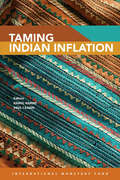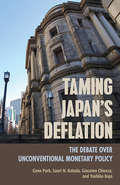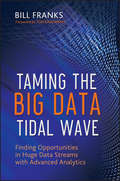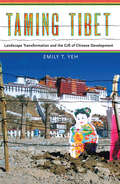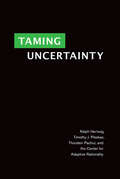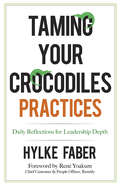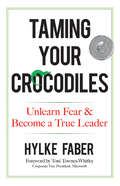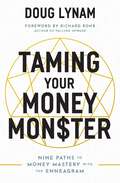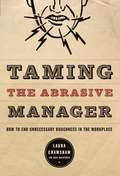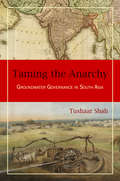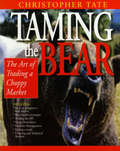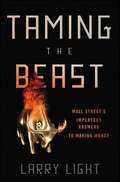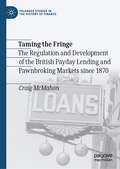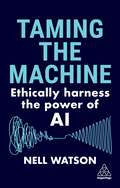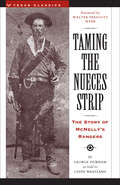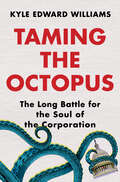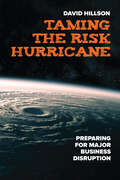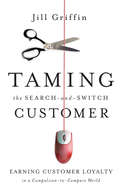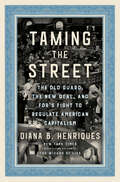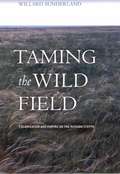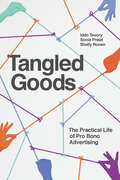- Table View
- List View
Taming Indian Inflation
by International Monetary FundHigh and persistent inflation in India has presented serious macroeconomic challenges, such as widening the current account deficit, exposing India to global financial market turbulence, and slowing growth. A number of factors have caused high inflation, including food inflation feeding quickly into wages and core inflation, entrenched inflation expectations, sector-specific supply constraints (particularly in agriculture, energy, and transportation), pass-through from a weaker rupee, and ongoing energy price increases. This book analyzes various facets of Indian inflation and their implications for the conduct of monetary policy in India. In particular, given the role of food inflation in driving inflation dynamics in India, several chapters are devoted exclusively to analyzing and managing food inflation. Building on the analysis of inflation dynamics, the book discusses the role of monetary policy in taming inflation, particularly given the costs of high and persistent inflation in India.
Taming Japan's Deflation: The Debate over Unconventional Monetary Policy (Cornell Studies in Money)
by Gene Park Giacomo Chiozza Saori N. Katada Yoshiko KojoBolder economic policy could have addressed the persistent bouts of deflation in post-bubble Japan, write Gene Park, Saori N. Katada, Giacomo Chiozza, and Yoshiko Kojo in Taming Japan's Deflation. Despite warnings from economists, intense political pressure, and well-articulated unconventional policy options to address this problem, Japan's central bank, the Bank of Japan (BOJ), resisted taking the bold actions that the authors believe would have significantly helped.With Prime Minister Abe Shinzo's return to power, Japan finally shifted course at the start of 2013 with the launch of Abenomics—an economic agenda to reflate the economy—and Abe's appointment of new leadership at the BOJ. As Taming Japan's Deflation shows, the BOJ's resistance to experimenting with bolder policy stemmed from entrenched policy ideas that were hostile to activist monetary policy. The authors explain how these policy ideas evolved over the course of the BOJ's long history and gained dominance because of the closed nature of the broader policy network.The explanatory power of policy ideas and networks suggests a basic inadequacy in the dominant framework for analysis ofthe politics of monetary policy derived from the literature on central bank independence. This approach privileges the interaction between political principals and their supposed agents, central bankers; but Taming Japan's Deflation shows clearly that central bankers' views, shaped by ideas and institutions, can be decisive in determining monetary policy. Through a combination of institutional analysis, quantitative empirical tests, in-depth case studies, and structured comparison of Japan with other countries, the authors show that, ultimately, the decision to adopt aggressive monetary policy depends largely on the bankers' established policy ideas and policy network.
Taming The Big Data Tidal Wave
by Bill FranksYou receive an e-mail. It contains an offer for a complete personal computer system. It seems like the retailer read your mind since you were exploring computers on their web site just a few hours prior....As you drive to the store to buy the computer bundle, you get an offer for a discounted coffee from the coffee shop you are getting ready to drive past. It says that since you're in the area, you can get 10% off if you stop by in the next 20 minutes....As you drink your coffee, you receive an apology from the manufacturer of a product that you complained about yesterday on your Facebook page, as well as on the company's web site....Finally, once you get back home, you receive notice of a special armor upgrade available for purchase in your favorite online video game. It is just what is needed to get past some spots you've been struggling with....Sound crazy? Are these things that can only happen in the distant future? No. All of these scenarios are possible today! Big data. Advanced analytics. Big data analytics. It seems you can't escape such terms today. Everywhere you turn people are discussing, writing about, and promoting big data and advanced analytics. Well, you can now add this book to the discussion.What is real and what is hype? Such attention can lead one to the suspicion that perhaps the analysis of big data is something that is more hype than substance. While there has been a lot of hype over the past few years, the reality is that we are in a transformative era in terms of analytic capabilities and the leveraging of massive amounts of data. If you take the time to cut through the sometimes-over-zealous hype present in the media, you'll find something very real and very powerful underneath it. With big data, the hype is driven by genuine excitement and anticipation of the business and consumer benefits that analyzing it will yield over time.Big data is the next wave of new data sources that will drive the next wave of analytic innovation in business, government, and academia. These innovations have the potential to radically change how organizations view their business. The analysis that big data enables will lead to decisions that are more informed and, in some cases, different from what they are today. It will yield insights that many can only dream about today. As you'll see, there are many consistencies with the requirements to tame big data and what has always been needed to tame new data sources. However, the additional scale of big data necessitates utilizing the newest tools, technologies, methods, and processes. The old way of approaching analysis just won't work. It is time to evolve the world of advanced analytics to the next level. That's what this book is about.Taming the Big Data Tidal Wave isn't just the title of this book, but rather an activity that will determine which businesses win and which lose in the next decade. By preparing and taking the initiative, organizations can ride the big data tidal wave to success rather than being pummeled underneath the crushing surf. What do you need to know and how do you prepare in order to start taming big data and generating exciting new analytics from it? Sit back, get comfortable, and prepare to find out!
Taming Tibet: Landscape Transformation and the Gift of Chinese Development
by Emily T. YehThe violent protests in Lhasa in 2008 against Chinese rule were met by disbelief and anger on the part of Chinese citizens and state authorities, perplexed by Tibetans apparent ingratitude for the generous provision of development. In Taming Tibet, Emily T. Yeh examines how Chinese development projects in Tibet served to consolidate state space and power. Drawing on sixteen months of ethnographic fieldwork between 2000 and 2009, Yeh traces how the transformation of the material landscape of Tibet between the 1950s and the first decade of the twenty-first century has often been enacted through the labor of Tibetans themselves. Focusing on Lhasa, Yeh shows how attempts to foster and improve Tibetan livelihoods through the expansion of markets and the subsidized building of new houses, the control over movement and space, and the education of Tibetan desires for development have worked together at different times and how they are experienced in everyday life. The master narrative of the PRC stresses generosity: the state and Han migrants selflessly provide development to the supposedly backward Tibetans, raising the living standards of the Han s little brothers. Arguing that development is in this context a form of indebtedness engineering, Yeh depicts development as a hegemonic project that simultaneously recruits Tibetans to participate in their own marginalization while entrapping them in gratitude to the Chinese state. The resulting transformations of the material landscape advance the project of state territorialization. Exploring the complexity of the Tibetan response to and negotiations with development, Taming Tibet focuses on three key aspects of China s modernization: agrarian change, Chinese migration, and urbanization. Yeh presents a wealth of ethnographic data and suggests fresh approaches that illuminate the Tibet Question.
Taming Uncertainty
by Ralph Hertwig Timothy J. Pleskac Thorsten PachurAn examination of the cognitive tools that the mind uses to grapple with uncertainty in the real world. How do humans navigate uncertainty, continuously making near-effortless decisions and predictions even under conditions of imperfect knowledge, high complexity, and extreme time pressure? Taming Uncertainty argues that the human mind has developed tools to grapple with uncertainty. Unlike much previous scholarship in psychology and economics, this approach is rooted in what is known about what real minds can do. Rather than reducing the human response to uncertainty to an act of juggling probabilities, the authors propose that the human cognitive system has specific tools for dealing with different forms of uncertainty. They identify three types of tools: simple heuristics, tools for information search, and tools for harnessing the wisdom of others. This set of strategies for making predictions, inferences, and decisions constitute the mind's adaptive toolbox. The authors show how these three dimensions of human decision making are integrated and they argue that the toolbox, its cognitive foundation, and the environment are in constant flux and subject to developmental change. They demonstrate that each cognitive tool can be analyzed through the concept of ecological rationality—that is, the fit between specific tools and specific environments. Chapters deal with such specific instances of decision making as food choice architecture, intertemporal choice, financial uncertainty, pedestrian navigation, and adolescent behavior.
Taming Your Crocodiles Practices: Daily Reflections for Leadership Depth
by Hylke Faber"Taming Your Crocodiles Practices is a personal tool for all leaders and followers looking to master authenticity and find greater purpose in their daily journey. Imagine the opportunity to explore who we are and what we want to accomplish — without fear. An extension of Hylke Faber's brilliant treatise, Taming Your Crocodiles, this book provides the component tools to unlearn fear-based leadership and practice constructive, creative, and inclusive behaviors with habit-forming frequency and consistency. A must for those ready to move past lip-service to liberation." — Toni Townes-Whitley, President, US Regulated Industries, Microsoft How do I lead from the depth of who I am rather than from fear-based, conditioned thinking?How do I shift my mindset to accelerate my growth?How do I turn self-discovery and service into a daily habit?How do I inspire others around me to keep growing and giving their best? Hylke Faber explores these and other questions, offering tools for implementing leadership practices into everyday life and work. The exercises in this book — which can be used both as a standalone guide and as a companion to the Nautilus Silver Award–winning book Taming Your Crocodiles — will deepen your appreciation for the adventure of life and leadership, help you connect with your true calling, turn your fears into growth practices, and guide you in supporting others on their growth journey. Praise for Taming Your Crocodiles Practices “How do we know ourselves? Practice! Hylke’s newest book offers us seventy-seven thoughtful and accessible practices toward greater self-discovery, creative expression and ever-expanding potential.” — Chris Ernst, Vice-President, Leadership & Organizational Effectiveness, Workday; author of Boundary Spanning Leadership “Taming Your Crocodiles Practices: Daily Reflections for Leadership Depth is a magical combination of deeply wise insights and specific methods to make these insights a reality in your life. I highly recommend this book for any aspiring leader looking to grow professionally but, more importantly, as a person.” —Matt Oppenheimer, CEO, Remitly “With great joy I have read this workbook. And it has pleased me to feel the vulnerability of the author, which opens ways for both the reader and the practitioner. Because of the vulnerability and openness of Hylke, he becomes more of a co-passenger than a coach who tells you how it is. Also, I like the fact that you have a choice of exercises related to your personal needs at every given moment. Hylke really connects to the material, which for me is the essence of personal leadership!” — Wiet de Bruijn, Partner, Delight Group; former CEO VBK Publishers “Hylke scores a home run again. Taming Your Crocodiles Practices: Daily Reflections for Leadership Depth is a unique and easy-to-read, practical book on personal and professional growth. Hylke reinforces key concepts from his first book, continuously taking the reader out of their comfort zone and posing challenging questions on how to think differently. In addition, by providing daily tips, he helps shape positive habits and behaviors, with a growth mindset, all required to be a great leader. I highly recommend his book for any current or future leader, as well as for a reader in search of a purposeful and meaningful life.” — Gioji Okuhara, Board Member & CEO, Brazilian consumer goods companies “Through this simple yet powerful and practical book, I continue to explore my fears, or crocodiles, and go deeper in myself. I connect to that place of peace and of a growth mindset. With my busy life and working with world<
Taming Your Crocodiles: Unlearn Fear & Become a True Leader
by Hylke Faber"I do believe that the issue of fear is personal and that is why it is buried in the workplace. Taming Your Crocodiles is groundbreaking not only because of its structured methodology, but also for its courage in calling out the issue itself. I am deeply impacted by Taming Your Crocodiles. I can speak personally and freely on this topic because this work has liberated me to lead more fearlessly at Microsoft and beyond." — Toni Townes-Whitley, Corporate Vice President, Microsoft Worldwide Public Sector and Industry What does it take to become a great leader? True leadership means freeing yourself from false, mostly borrowed constraints, charting a purpose-filled path based on values that reflect who you really are, and inspiring others to do the same. Before becoming a coach to CEOs and other leaders worldwide, Hylke Faber had his own transformational journey, stepping back from a high-stress career as a strategy consultant in New York City and almost becoming a monk in order to discover a more holistic approach to life. This book distills his experience into a guide that will help you grow into the leader you really are by transforming your "crocodilian" fear-based conditioning into "owls" — mindsets and behaviors that reflect your true essence. In this bold, comprehensive book, Hylke offers practical advice for coaching yourself and others, both one-on-one and one-to-many, influencing the people around you to evolve their mindsets and behaviors to a more authentic place. Every chapter includes tools Hylke has successfully used in his work that you can apply to become a more truthful leader, both at work and at home. With Taming Your Crocodiles, you can learn how to let go of fear, unlock your potential for growth, and foster a supportive environment for your team, in which presence, learning, contribution, and excellence merge. Some of the tools include AWE (Always Willing to Evolve), LOVE (Letting Others Voluntarily Evolve), and SUCCESS (be a Samurai, Unite, Center in Purpose, be Curious, Extend Contribution, Sense Your Environment and be Simple). "Taming Your Crocodiles is a daring and important addition to the field of leadership development. It's personal, provocative, and practical. It challenges us to become radically honest with ourselves about who we really are and how our learned crocodilian fears are holding us back from who we can be. And it provides an inspiring, well-structured path to help us coach ourselves and others to let go of our crocodiles and lead from a place that realizes much more of our true potential." — Vijay Govindarajan, Coxe Distinguished Professor, Dartmouth College's Tuck School of Business; Marvin Bower Fellow 2015–16, Harvard Business School; New York Times, Wall Street Journal bestselling author "In this simple but transformative book, you have everything — absolutely everything — you need to go on life's greatest journey to grow as a leader, not by changing yourself but rather by discovering who you are becoming." — Chris Ernst, Director, Learning & Organization Effectiveness, Bill & Melinda Gates Foundation; author of Boundary Spanning Leadership "Inspiring, thought-provoking, and comprehensive. Taming Your Crocodiles offers a compelling combination of process, stories, and practice. It invites us to reflect on who we are and how to lead ourselves and others from an authentic place. Including lessons from the great leaders of our time, it helps readers to evolve by becoming more conscious of their inherent strengths and more free from self-limiting mind-sets and behaviors. A must-read for anyone who wishes to grow their leadership to the next level!" — Joel Brockner, Phillip Hettleman Professor of Business, Columbia Business School
Taming Your Money Monster: 9 Paths to Money Mastery with the Enneagram
by Doug LynamFinance expert Doug Lynam offers a groundbreaking exploration of our complex relationship with money, budgeting, and finances through the transformative lens of the Enneagram. Confront financial fears, engage with money habits and behaviors, and develop a personal understanding of how the mind and personality affect money decisions. With compassion, wisdom, and humor, Lynam will guide readers on a journey to financial health and personal growth.Drawing from his diverse experiences as a marine, monk, and money manager, Lynam introduces readers to our "money monsters", which correspond to our Enneagram type and attachment style to money. These archetypes represent our deepest financial fears and self-sabotaging behaviors.But Lynam doesn't just identify our financial foibles—he provides a clear, actionable path to overcome them. With sharp wit and profound understanding, he shows you how to:recognize and understand your money monster's origins in your childhood experiences;identify and understand your "ego addictions" and their impact on your financial decisions;transform your financial vices into virtues, creating a foundation for lasting abundance;discover your unique "sacred gift" and how to use it to build wealth and create positive change in the world; andadjust how you earn, save, and invest to become a money master. Taming Your Money Monster isn't just about improving your bank balance—it's about healing your relationship with money on a deep, spiritual level. Lynam's approach acknowledges that true financial mastery comes from aligning your monetary practices with your deepest values and authentic self.This is more than a financial advice book—it's a compassionate guide to personal growth, spiritual enlightenment, and financial freedom. Because when we heal our relationship with money, we heal our relationship with ourselves.
Taming the Abrasive Manager: How to End Unnecessary Roughness in the Workplace
by Laura CrawshawTaming the Abrasive Manager is an ideal resource for managers, human resource professionals, coaches, and anyone who works for or with an abrasive boss. Executive coach Dr. Laura Crawshaw— known as the "Boss Whisperer" for her work in this field—shares her discoveries on how to tame the deep fears that drive abrasive managers to attack their coworkers. In her straight-shooting style, Crawshaw offers invaluable insights gained from her encounters with abrasive bosses in corporate jungles who aggressively defend against threats to their dominance in the high-risk business of survival. These insights, combined with lessons learned from employees and organizations who have successfully reined in their unmanageable bosses, provide realistic solutions that will improve the workplace for everyone.
Taming the Anarchy: Groundwater Governance in South Asia
by Tushaar ShahIn 1947, British India-the part of South Asia that is today's India, Pakistan, and Bangladesh-emerged from the colonial era with the world's largest centrally managed canal irrigation infrastructure. However, as vividly illustrated by Tushaar Shah, the orderly irrigation economy that saved millions of rural poor from droughts and famines is now a vast atomistic system of widely dispersed tube-wells that are drawing groundwater without permits or hindrances. Taming the Anarchy is about the development of this chaos and the prospects to bring it under control. It is about both the massive benefit that the irrigation economy has created and the ill-fare it threatens through depleted aquifers and pollution. Tushaar Shah brings exceptional insight into a socio-ecological phenomenon that has befuddled scientists and policymakers alike. In systematic fashion, he investigates the forces behind the transformation of South Asian irrigation and considers its social, economic, and ecological impacts. He considers what is unique to South Asia and what is in common with other developing regions. He argues that, without effective governance, the resulting groundwater stress threatens the sustenance of the agrarian system and therefore the well being of the nearly one and a half billion people who live in South Asia. Yet, finding solutions is a formidable challenge. The way forward in the short run, Shah suggests, lies in indirect, adaptive strategies that change the conduct of water users. From antiquity until the 1960‘s, agricultural water management in South Asia was predominantly the affair of village communities and/or the state. Today, the region depends on irrigation from some 25 million individually owned groundwater wells. Tushaar Shah provides a fascinating economic, political, and cultural history of the development and use of technology that is also a history of a society in transition. His book provides powerful ideas and lessons for researchers, historians, and policy
Taming the Bear
by Christopher TateA bear market may last for a week, a month or even a few years, but it can take only a day, an hour or even a few minutes for the value of an investment portfolio to be slashed to half of its former value. Some bear markets start with a bang, like the crash of ?7, others creep up slowly so that investors do not realise they are in a bear market and carry on as if nothing has happened. Of course, not even the experts can accurately forecast what the market will do. However, there are signs that can indicate a bear market is approaching and, if recognised, give prudent investors time to take steps to safeguard their portfolios. The first part of this book describes how to recognise the signals that might precede a bear market, and how to watch the various indices for sell signals. The second part deals with methods to help both investors and traders to survive by understanding what changes in volume represent, when to use a moving average and how to stay ahead of the pack. Chris Tate guides the reader step-by-step through his methods, as well as using examples from his own extensive trading experience. He uses charts to explain what to look for in the market and what action to take. This is written in his usual easy-to-understand style.
Taming the Beast
by Larry LightA compelling financial narrative on flexible strategies investors can use to protect their assetsWhich is the best strategy for protecting your investments? Value investing? Indexing? Hedging? Growth investing? Asset allocation? It all depends upon the market because, although Wall Street has tried time and time again to devise a single system to tame the beast, the only thing that's constant about the market is that it's always changing and no one system will work perfectly to protect your assets each and every time.Taming the Beast: Wall Street's Imperfect Answers to Making Money presents the various strategies, and shows you how the best strategy is to be both flexible and nimble.Details the origins and evolutions of Wall Street's most popular trading strategiesDescribes who originated the strategy, and those who contributed to itAnalyzes each strategy's strengths and weaknessesAs Benjamin Graham noted in the 1930s, investors would be well advised to avoid getting mired in one set of beliefs. Times change, and so do markets. The key is to be flexible. Taming the Beast shows you how.
Taming the Elephant (How to Overcome the Forgetting Challenge)
by Chris Trimble Vijay GovindarajanContinuing the story of Corning Microarray Technologies (CMT), this chapter describes how Corning changed CMT's organizational design, and explains how this reconstruction of a new and distinct organizational DNA accelerated progress. The authors then develop a framework that guides organizational choices to help a new company cope effectively with the forgetting challenge.
Taming the Fringe: The Regulation and Development of the British Payday Lending and Pawnbroking Markets since 1870 (Palgrave Studies in the History of Finance)
by Craig McMahonTaming the Fringe analyses the regulation and evolution of two credit products that were, and remain, vital to the working poor. Policymakers have struggled with pawnbroking and moneylending because they raise broader issues pertaining to poverty, capitalism and financial regulation. The values of easily accessible credit and financial independence compete with society’s desire to protect people from predatory loans. Policymakers have pondered whether regulation can lower costs without reducing access for those most in need of small cash loans. Can government policy protect borrowers while also providing sufficient profit for lenders? The many attempts at doing so reveal the difficulty of safeguarding the needs of people who have experienced financial trouble before seeking a loan. Taming the Fringe is the first extended study of the payday lending and pawnbroking markets in Britain, and the only one to examine over 160 years of financial results and market data. This work explains why small-value lenders have generated such passionate debate, even being described as the devil incarnate. It adds to our knowledge of fringe banking and the evolving role of financial regulation to protect the working poor. Since 1870, pawnbrokers and moneylenders have actively shaped regulation – a viewpoint the existing literature does not address adequately. This work contributes to the scholarly and policy dialogue on financial inclusion, working-class poverty and the development and legitimacy of fringe lending. This book analyses the motivation, content and outcome of critical regulatory episodes that have shaped fringe banking. While historians have written volumes about consumer credit, few have analysed why elite policymakers have sought to protect the working poor from some credit markets. This work demonstrates that, across time, conflicting views on poverty and liberal economic theory have, to varying degrees, influenced how the government has protected the working poor, and will be of interest to financial and economic historians.
Taming the Machine: Ethically Harness the Power of AI
by Nell WatsonAI promises to transform our world, supercharging productivity and driving new innovations. Taming the Machine uncovers how you can responsibly harness the power of AI with confidence.AI has the potential to become a personal assistant, a creative partner, an editor and a research tool all at once. But it also represents a threat to your livelihood, data and privacy. Taming the Machine offers the practical insights and knowledge you need to work with AI with an ethical and responsible approach.In this book, celebrated AI expert and ethicist Nell Watson offers practical insights on how you can ethically innovate with AI. It delves into the ethical issues of unbridled AI, highlighting the challenges that it will bring to society and business unless we fortify cybersecurity, safeguard our data, and understand the dangerous potential of artificial intelligence.Step into the future and supercharge your performance safely by Taming the Machine.
Taming the Money Sharks
by Philip Shu-Ying ChengEasy-to-follow guidelines from a pro for simplifying your investments, protecting yourself from the investment sharks and achieving financial freedom Drawing on his years as an investor for leading banks in the U.S. and Asia, Philip Cheng delivers down-to-earth strategies guaranteed to make you "shark-proof" while you optimize investment returns. Statistics show that only 20% of small investors ever come close to achieving their investment goals. The other 80% get eaten alive by "investment sharks"--investment advisors, fund managers and other hucksters out to line their pockets with your hard-earned cash. Motivated by a sense of fair play, Cheng resolved to write an investor's survival guide in which he'd share everything he's learned in his years as a successful professional investor. The result is Taming the Money Sharks. The easy-to-follow guidelines you'll find in this book will help you navigate the shark-infested waters of the investment world, all the way to the financial freedom you dream of and deserve.A must-have survival guide for novice investors, and a source of fresh thinking and innovative strategies for experienced investorsFeatures many illustrations, summaries, charts, real-world examples along with other powerful tools to help you avoid common mistakes and win at the investment gameLays out 8 proven strategies for investing systematically and surviving and thriving in the shark-infested waters of the stock market
Taming the Nueces Strip: The Story of McNelly's Rangers (Texas Classics)
by George Durham Clyde Wantland&“Durham&’s account is modest and straightforward . . . has many lessons for anyone interested in the history of the Old West, leadership or law enforcement.&” —American West Review Only an extraordinary Texas Ranger could have cleaned up bandit-plagued Southwest Texas, between the Nueces River and the Rio Grande, in the years following the Civil War. Thousands of raiders on horseback, some of them Anglo-Americans, regularly crossed the river from Mexico to pillage, murder, and rape. Their main objective? To steal cattle, which they herded back across the Rio Grande to sell. Honest citizens found it almost impossible to live in the Nueces Strip. In desperation, the governor of Texas called on an extraordinary man, Captain Leander M. McNelly, to take command of a Ranger company and stop these border bandits. One of McNelly&’s recruits for this task was George Durham, a Georgia farm boy in his teens when he joined the &“Little McNellys,&” as the Captain&’s band called themselves. More than half a century later, it was George Durham, the last surviving &“McNelly Ranger,&” who recounted the exciting tale of taming the Nueces Strip to San Antonio writer Clyde Wantland. In Durham&’s account, those long-ago days are brought vividly back to life. Once again the daring McNelly leads his courageous band across Southwest Texas to victories against incredible odds. With a boldness that overcame their dismayingly small number, the McNellys succeeded in bringing law and order to the untamed Nueces Strip—succeeded so well that they antagonized certain &“upright&” citizens who had been pocketing surreptitious dollars from the bandits&’ operations. &“The reader seems to smell the acrid gunsmoke and to hear the creak of saddle leather.&” —Southwestern Historical Quarterly
Taming the Octopus: The Long Battle for the Soul of the Corporation
by Kyle Edward WilliamsThe untold story of how efforts to hold big business accountable changed American capitalism. Recent controversies around environmental, social, and governance (ESG) investing and “woke capital” evoke an old idea: the Progressive Era vision of a socially responsible corporation. By midcentury, the notion that big business should benefit society was a consensus view. But as Kyle Edward Williams’s brilliant history, Taming the Octopus, shows, the tools forged by New Deal liberals to hold business leaders accountable, such as the Securities and Exchange Commission, narrowly focused on the financial interests of shareholders. This inadvertently laid the groundwork for a set of fringe views to become dominant: that market forces should rule every facet of society. Along the way, American capitalism itself was reshaped, stripping businesses to their profit-making core. In this vivid and surprising history, we meet activists, investors, executives, and workers who fought over a simple question: Is the role of the corporation to deliver profits to shareholders, or something more? On one side were “business statesmen” who believed corporate largess could solve social problems. On the other were libertarian intellectuals such as Milton Friedman and his oft-forgotten contemporary, Henry Manne, whose theories justified the ruthless tactics of a growing class of corporate raiders. But Williams reveals that before the “activist investor” emerged as a capitalist archetype, Civil Rights groups used a similar playbook for different ends, buying shares to change a company from within. As a rising tide of activists pushed corporations to account for societal harms from napalm to environmental pollution to inequitable hiring, a new idea emerged: that managers could maximize value for society while still turning a maximal profit. This elusive ideal, “stakeholder capitalism,” still dominates our headlines today. Williams’s necessary history equips us to reconsider democracy’s tangled relationship with capitalism.
Taming the Risk Hurricane: Preparing for Major Business Disruption
by David HillsonA leading expert on risk management describes how to steer your company through a risk hurricane-the extreme risk exposure that can lead to major disruption for your business.Risk management has become a standard part of the strategic tool kit, providing senior leaders with a forward-looking radar to scan the future and give early warnings of approaching threats and opportunities. However, even best-in-class organizations can falter in the face of extreme risk exposure. Special circumstances demand special responses, and extreme risk exposure needs very careful handling. Routine risk management approaches will fall short, but businesses that demonstrate a high degree of flexibility and resilience will have the competitive advantage and the ability to thrive where others fail.The causes and consequences of meteorological hurricanes have parallels in the way uncontrolled risk exposure can develop in organizations. Both are caused largely by predictable factors, but both are characterized by sustained uncertainty and severe impact once they develop. If we can learn to predict a risk hurricane, prepare for it effectively, and survive its effects, then our organizations will be well placed to address the challenge of extreme risk exposure, if and when we are unfortunate enough to face it.
Taming the Search-and-Switch Customer
by Jill GriffinPraise for Taming the Search-and-Switch Customer"What an excellent wake-up call! Your company's most valuable asset-your loyal customers-have more tools than ever to compare you to competitors and switch. Griffin does an excellent job identifying the risks to customer loyalty in an environment of immediate and abundant information, and defines a path to earn loyalty through delivery of enhanced value in the eyes of your customers. A truly important premise to building and maintaining a successful business."?-Gerald Evans, president, Hanes Brands Supply Chain and Asia Business Development"In this dynamic treatise on customer retention, Jill Griffin, The Loyalty Maker, provides updated solutions to meet today's challenge of changing consumer shopping habits. A must-read for all retailers and wholesalers."-Britt Jenkins, chairman of the board, Tandy Brand Accessories, Inc."Mandatory reading for anyone who manages customer loyalty. A truly thought-provoking read!"-Timothy Keiningham, global chief strategy officer, executive vice president, IPSOS Loyalty"Every company is in the service business now, whether they realize it or not. Jill's book is a great start on how to make your service experiences better than they are today."-Robert Stephen, founder, The Geek Squad"In today's Googlized marketplace, Taming the Search-and-Switch Customer is a must-read."-Ken DeAngelis, general partner, Austin Ventures"Griffin is pure loyalty genius!"-Kelly Cook, vice president, Customer Engagement/CRM, Waste Management
Taming the Street: The Old Guard, the New Deal, and FDR's Fight to Regulate American Capitalism
by Diana B. HenriquesThe &“extraordinary&” (New York Times Book Review, Editors&’ Choice) story of FDR&’s fight for the soul of American capitalism—from award-winning journalist Diana B. Henriques, author of The Wizard of Lies: Bernie Madoff and the Death of Trust&“I thought I was well versed in the New Deal, but it turns out I knew next to nothing. Diana Henriques&’s chronicle is meticulous, illuminating, and riveting.&”—Kurt Andersen, New York Times bestselling author of Evil Geniuses and FantasylandTaming the Street describes how President Franklin D. Roosevelt battled to regulate Wall Street in the wake of the 1929 stock market crash and the ensuing Great Depression. With deep reporting and vivid storytelling, Diana B. Henriques takes readers back to a time when America&’s financial landscape was a jungle ruled by the titans of vast wealth, largely unrestrained by government. Roosevelt ran for office in 1932 vowing to curb that ruthless capitalism and make the world of finance safer for ordinary savers and investors. His deeply personal campaign to tame the Street is one of the great untold dramas in American history. Success in this political struggle was far from certain for FDR and his New Deal allies, who included the political dynasty builder Joseph P. Kennedy and the future Supreme Court justice William O. Douglas. Wall Street&’s old guard, led by New York Stock Exchange president Richard Whitney, fought every new rule to the &“last legal ditch.&” That clash—between two sharply different visions of financial power and federal responsibility—has shaped how &“other people&’s money&” is managed in the United States to this day. As inequality once again reaches Jazz Age levels, Henriques brings to life a time when the system worked—an idealistic moment when ordinary Americans knew what had to be done and supported leaders who could do it. A vital history and a riveting true-life thriller, Taming the Street raises an urgent and troubling question: What does capitalism owe to the common good?
Taming the Wild Field: Colonization and Empire on the Russian Steppe
by Willard SunderlandWillard Sunderland chronicles the colonization of the Russian steppes & discusses how the steppe lands have changed in the Russian imagination over time, from the 'wild field' of the middle ages, to the iconic status of the 19th century, when the vast grasslands had become a symbol of Russian nationhood.
Tanfeeth: Bringing Service Excellence to the GCC
by Lynda M. Applegate Arnold B. PeinadoTanfeeth, a business process outsourcing (BPO) firm in the United Arab Emirates, was founded in July 2011 as a fully owned subsidiary of Emirates NBD, the largest bank in the Gulf Corporation Council. When Tanfeeth was founded, Emirates NBD, along with the leaders of Tanfeeth, decided that Tanfeeth would begin by improving processes at the bank. However, two years after its founding, some Tanfeeth executives felt that the organization needed to take on work from outside clients. They were concerned that if Tanfeeth waited too long, its first-mover advantage and position as market leader would deteriorate. Additionally, if Emirates NBD held back Tanfeeth's growth ambitions, some of the world-class talent Tanfeeth had been able to attract might leave. What was the best course of action for Emirates NBD and Tanfeeth?
Tangled Goods: The Practical Life of Pro Bono Advertising
by Iddo Tavory Sonia Prelat Shelly RonenA novel investigation of pro bono marketing and the relationship between goods, exploring the complex moral dimensions of philanthropic advertising. The advertising industry may seem like one of the most craven manifestations of capitalism, turning consumption into a virtue. In Tangled Goods, authors Iddo Tavory, Sonia Prelat, and Shelly Ronen consider an important dimension of the advertising industry that appears to depart from the industry’s consumerist foundations: pro bono ad campaigns. Why is an industry known for biting cynicism and cutthroat competition also an industry in which people dedicate time and effort to “doing good”? Interviewing over seventy advertising professionals and managers, the authors trace the complicated meanings of the good in these pro bono projects. Doing something altruistic, they show, often helps employees feel more at ease working for big pharma or corporate banks. Often these projects afford them greater creative leeway than they normally have, as well as the potential for greater recognition. While the authors uncover different motivations behind pro bono work, they are more interested in considering how various notions of the good shift, with different motivations and benefits rising to the surface at different moments. This book sheds new light on how goodness and prestige interact with personal and altruistic motivations to produce value for individuals and institutions and produces a novel theory of the relationship among goods: one of the most fraught questions in sociological theory.
Tangled Goods: The Practical Life of Pro Bono Advertising
by Iddo Tavory Sonia Prelat Shelly RonenA novel investigation of pro bono marketing and the relationship between goods, exploring the complex moral dimensions of philanthropic advertising. The advertising industry may seem like one of the most craven manifestations of capitalism, turning consumption into a virtue. In Tangled Goods, authors Iddo Tavory, Sonia Prelat, and Shelly Ronen consider an important dimension of the advertising industry that appears to depart from the industry’s consumerist foundations: pro bono ad campaigns. Why is an industry known for biting cynicism and cutthroat competition also an industry in which people dedicate time and effort to “doing good”? Interviewing over seventy advertising professionals and managers, the authors trace the complicated meanings of the good in these pro bono projects. Doing something altruistic, they show, often helps employees feel more at ease working for big pharma or corporate banks. Often these projects afford them greater creative leeway than they normally have, as well as the potential for greater recognition. While the authors uncover different motivations behind pro bono work, they are more interested in considering how various notions of the good shift, with different motivations and benefits rising to the surface at different moments. This book sheds new light on how goodness and prestige interact with personal and altruistic motivations to produce value for individuals and institutions and produces a novel theory of the relationship among goods: one of the most fraught questions in sociological theory.
